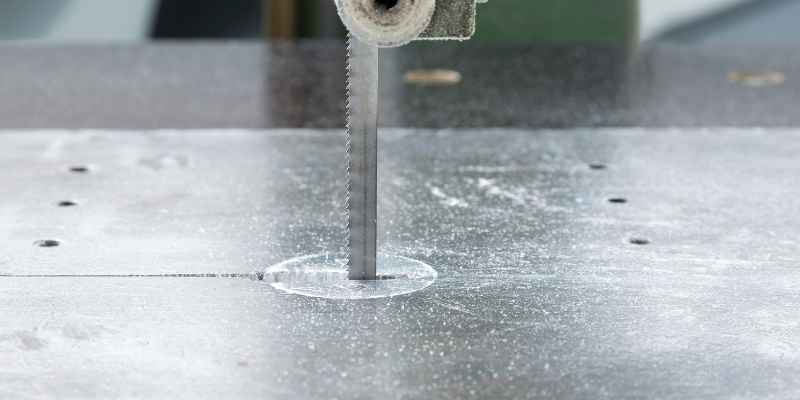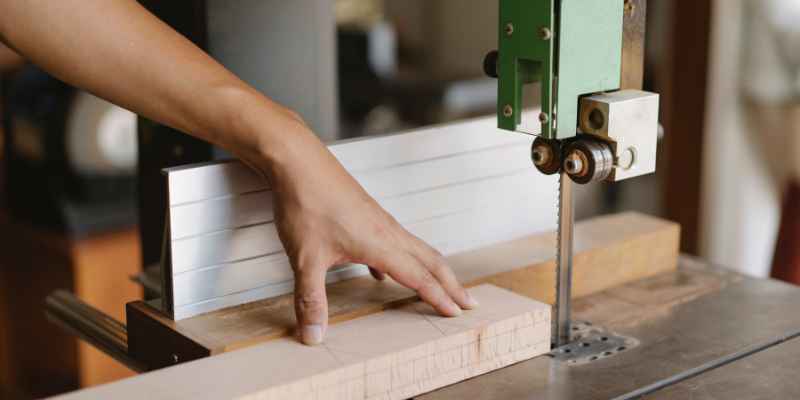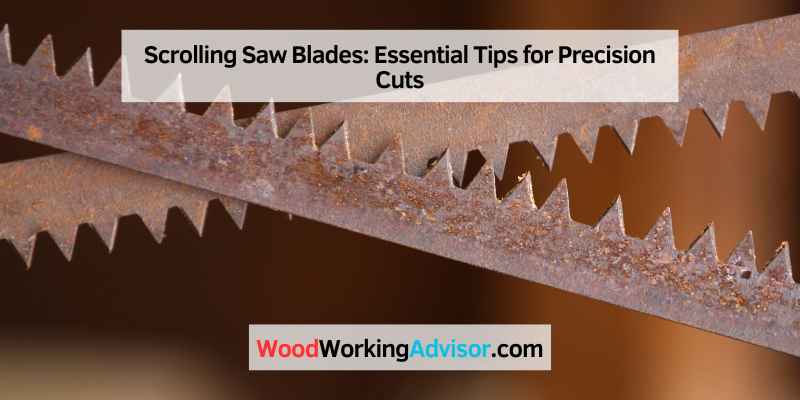Scrolling saw blades are essential tools for intricate woodworking projects, offering precise and efficient cutting capabilities. Are you a woodworking enthusiast?
Do you love creating intricate and detailed designs? If so, you know the importance of having the right tools for the job. One such tool that plays a vital role in woodworking is the scrolling saw blade. These blades provide precise and efficient cutting, allowing you to create intricate patterns and designs with ease.
Whether you’re working on a small hobby project or a larger professional task, choosing the right scrolling saw blade is crucial for achieving the best results. We will explore the world of scrolling saw blades, their types, and how to select the perfect one for your woodworking needs. So, let’s dive into the fascinating world of scrolling saw blades and unleash your woodworking creativity!
Choosing The Right Blade
If you want to achieve precise and clean cuts while working with a scrolling saw, choosing the right blade is crucial. The blade you select will determine the quality and accuracy of your work. There are several factors to consider when it comes to choosing the perfect scrolling saw blade. Let’s dive in and explore some key points to keep in mind when selecting a blade that suits your needs.
Understanding Tooth Patterns
One of the most important considerations when choosing a scrolling saw blade is understanding the different tooth patterns available. Each tooth pattern is designed for specific cutting tasks, and selecting the appropriate pattern can make a significant difference in the outcome of your project.
Here are a few common tooth patterns and their uses:
| Tooth Pattern | Best for |
|---|---|
| Standard Tooth | General purpose cutting in wood and plastic |
| Reverse Tooth | Reducing splintering on the top surface of the material |
| Skip Tooth | Rapidly removing stock while preventing clogging |
Considering Thickness And Material
Another crucial factor to consider when choosing a scrolling saw blade is the thickness and material of the blade. Different thicknesses are suitable for various cutting tasks, so it’s important to select the right thickness for your project.
Additionally, blades are available in a range of materials such as high-carbon steel, bi-metal, and carbide-tipped. Each material offers different benefits and strengths, so choose the one that best suits your needs.
In conclusion, choosing the right blade for your scrolling saw is essential if you want to achieve precise and clean cuts in your woodworking projects. By understanding the tooth patterns and considering the thickness and material, you can make an informed decision and ensure the success of your projects.
Scroll Saw Blades in summary
- Understand the tooth patterns and their uses
- Consider the thickness and material of the blade
Therefore, follow these guidelines and select the perfect scrolling saw blade for your needs.

Maintenance And Care
Proper care and maintenance of scrolling saw blades are essential to ensure smooth and accurate cuts and prolong the lifespan of the blades. By following a few simple steps, you can maximize the performance of your blades and ensure they remain in top condition for longer.
Cleaning Blades Regularly
Regularly cleaning your scrolling saw blades is crucial to prevent dirt, debris, and buildup from affecting their performance. Use a wire brush or a specialized cleaning solution designed for saw blades to remove resin, pitch, and other buildup. Ensure that the blade is completely dry before reattaching it to the scrolling saw to prevent rusting and corrosion.
Checking For Damage
Inspect your scrolling saw blades frequently for any signs of damage, such as missing or chipped teeth, warping, or bending. If you notice any damage, immediately replace the blade to maintain the precision and safety of your scrolling saw. Regular checks for damage will help you avoid potential accidents and ensure consistent cutting performance.
Adjusting Blade Tension
Adjusting blade tension is a crucial step in maintaining the efficiency and accuracy of scrolling saw blades. It ensures smooth cuts and reduces blade breakage, allowing for optimal performance during woodworking projects.
Adjusting the tension of scrolling saw blades is crucial for ensuring the quality and accuracy of your cuts. Improper tension can lead to blade breakage, inaccurate cuts, and potential safety hazards. Therefore, it is essential to understand the importance of proper tension and how to adjust it correctly.
Importance Of Proper Tension
Proper tension is paramount to ensure the scrolling saw blade functions optimally. Inadequate tension can result in the blade wandering, creating uneven cuts, and potentially damaging your workpiece. Conversely, excessive tension can lead to the blade breaking prematurely, posing a safety risk. Therefore, maintaining the right tension is critical for achieving precise and safe cutting results.
How To Adjust Tension
Adjusting the tension of a scrolling saw blade requires precision and care. Follow these steps to ensure the proper adjustment of your blade tension:
1. Turn off the scrolling saw and unplug it from the power source.
2. Identify the tensioning mechanism on your scrolling saw. This can typically be found at the back of the upper arm.
3. Loosen the blade tension by turning the tensioning knob counterclockwise.
4. Carefully remove the old blade while ensuring your fingers are clear of the blade clamp.
5. Insert the new blade through the blade guide and into the blade holder, ensuring it is properly seated.
6. Gradually tighten the tensioning knob by turning it clockwise until the blade is taut but not overly stretched.
7. Gently pluck the blade to ensure it emits a clear, high-pitched sound – indicating optimal tension.
8. Finally, plug the saw back in and test the tension by making a test cut.
By following these steps, you can ensure the scrolling saw blade is correctly tensioned, resulting in precise and safe cutting operations.
Techniques For Precision Cuts
When it comes to scrolling saw blades, one of the most important factors in achieving precise cuts is using the right technique. Whether you’re aiming for straight, curved, or intricate designs, having the right approach can make all the difference in the final result. Here, we’ll explore some essential techniques that will help you achieve the precision cuts you desire.
Using A Fence For Straight Cuts
When it comes to cutting straight lines with scrolling saws, using a fence is a game-changer. A fence is a guide that helps you maintain a steady and straight cut along the designated path. It can be as simple as a straight board clamped securely to your work surface, or you can also invest in a specialized fence designed specifically for scrolling saws.
When using a fence, be sure to position it to the desired distance from the blade, ensuring it’s parallel to your cut. This will provide a steady reference point and prevent any unwanted deviations. Additionally, make sure that your workpiece is securely held in place and that the blade is aligned with the marked line.
Making Curved Cuts
Making curved cuts with a scrolling saw requires a different approach compared to straight cuts. One technique you can employ is using a template. By creating a template out of a solid material like plywood or MDF, you can trace the desired curve onto your workpiece, allowing for precise and consistent cuts every time.
To create a template, first, draw the desired curve onto the template material, ensuring it’s smooth and accurate. Next, cut along the drawn line using a band saw or jigsaw. Once you have your template, secure it to the workpiece using clamps or double-sided tape. Then, using your scrolling saw, carefully follow the template’s contour to achieve the desired curved cut.
Another technique that can be employed for curved cuts is called “freehand cutting.” This approach requires practice and a steady hand. By following the marked line with your scrolling saw, you can gradually navigate the curves, making slight adjustments as necessary to ensure precision and maintain control throughout the cutting process.
Remember, when making curved cuts, patience is key. Take your time and go slow, allowing the blade to do the work while you guide the saw along the marked line.
Summary:
- Use a fence to achieve straight cuts with scrolling saws.
- Create templates for consistent and precise curved cuts.
- Practice freehand cutting for intricate and unique designs.
- Take your time and go slow when making curved cuts.
Safety Precautions
Scroll saws are versatile tools, but it’s crucial to follow safety precautions to prevent accidents.
Wearing Protective Gear
Protective gear includes safety glasses, dust mask, and ear protection to shield against hazards.
Securing Workpiece
Secure your workpiece with clamps or a vise to avoid it from moving unpredictably.
Troubleshooting Common Issues
When using a scrolling saw, you may encounter common issues that can affect the quality of your cuts. Troubleshooting these problems promptly can help you achieve optimal results and maintain the efficiency of your equipment. Below are some common issues you may face when using scrolling saw blades:
Blade Drifting
Blade drifting refers to the blade veering off course during cutting, resulting in inaccurate designs. To address this issue:
- Check blade tension to ensure it is properly adjusted.
- Inspect the blade alignment and make necessary adjustments.
- Choose the right blade type and size for the material you are cutting.
Uneven Cuts
Uneven cuts can mar the finish of your project and indicate potential blade or technique issues. To resolve this problem:
- Ensure the blade is sharp and properly installed.
- Adjust the cutting speed to match the material density.
- Use a steady hand and maintain consistent pressure while cutting.
Advanced Tips And Tricks
In this section, we’ll explore advanced tips and tricks for using scrolling saw blades to achieve intricate designs and optimize stack cutting. Mastering these techniques can take your scrolling saw work to the next level.
Stack Cutting Techniques
Stack cutting is a method used by scrolling saw enthusiasts to create multiple identical designs simultaneously. This technique saves time and ensures consistency in your work. To effectively stack cut with scrolling saw blades, it’s important to use sharp, fine-toothed blades. Additionally, securing the stack firmly with proper clamps or vises will prevent materials from shifting during cutting, resulting in clean, precise cuts on all pieces. Careful blade selection and good material support are key components for successful stack cutting.
Intricate Design Tips
To achieve intricate designs with scrolling saw blades, consider using spiral blades that allow for cutting in any direction. Tensioning the blade properly is crucial for cutting tight corners and complex shapes. Adjusting tension throughout the cutting process can aid in navigating intricate details. Moreover, selecting the appropriate blade size for the intricacy of the design will minimize excess material removal. Remember to keep the saw blade perpendicular to the material, and make small, precise movements to achieve detailed and polished designs.

Frequently Asked Questions Of Scrolling Saw Blades
What Are The Different Types Of Scrolling Saw Blades Available?
Scrolling saw blades come in various types such as skip tooth, double skip, and reverse. Each type is designed for specific cutting purposes and materials, providing versatility and precision for intricate woodworking projects.
How To Choose The Right Scrolling Saw Blade For My Project?
Consider the type of material you’ll be cutting, the thickness, and the intricacy of your design. Selecting the appropriate blade type and size is crucial for achieving clean and precise cuts in your woodworking projects.
Can Scrolling Saw Blades Be Used For Cutting Metal Materials?
Yes, scrolling saw blades can be used to cut thin metal materials, such as aluminum and brass. However, it’s important to choose the right blade type and ensure that the speed and feed settings are adjusted accordingly for optimal results.
Conclusion
To sum up, scrolling saw blades are an essential tool for any woodworking enthusiast, whether you’re a beginner or a seasoned professional. With their precision and versatility, they allow you to create intricate and detailed cuts with ease. By choosing the right blade for your specific project, you can achieve excellent results and bring your woodworking skills to the next level.
So, don’t hesitate to invest in high-quality scrolling saw blades and unleash your creativity in the world of woodworking.


